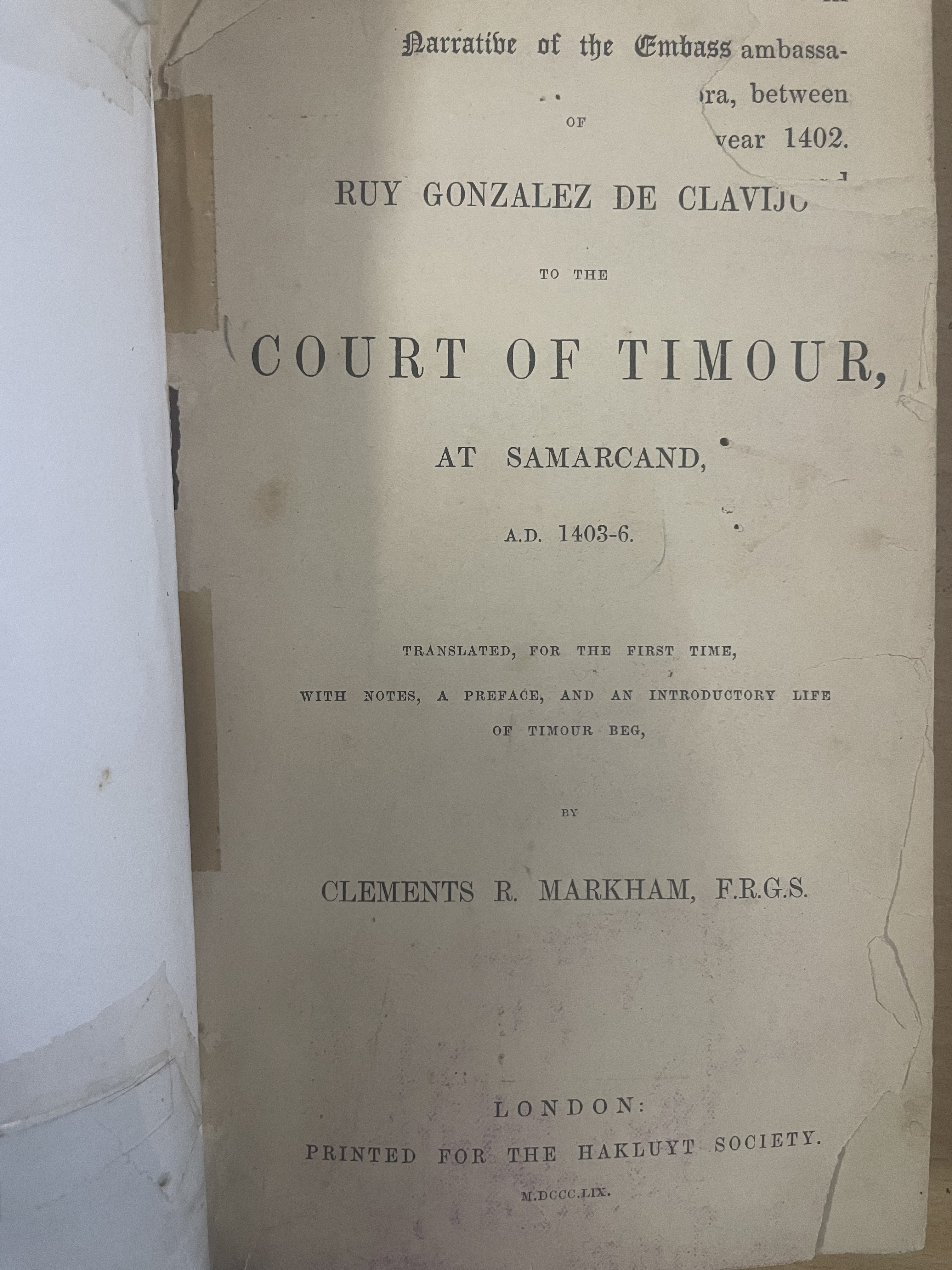Court of Timour

About
Summary
Exquisite
TOC
Details
Related
URL
Images
Overview
The book in question is Narrative of the Embassy of Ruy Gonzalez de Clavijo to the Court of Timour at Samarcand, A.D. 1403-6, edited by Clements R. Markham. Markham was a British geographer, writer, and explorer who edited and translated numerous travel narratives for the Hakluyt Society. Ruy González de Clavijo was a Castilian ambassador sent to the court of Timur (also known as Tamerlane) in Samarkand in the early 15th century. Markham's edition makes Clavijo's account accessible to a wider audience.
Importance of Book
First-hand Account: Clavijo's narrative provides a first-hand account of a European embassy to the court of Timur, offering a unique perspective on a significant moment in diplomatic history.
Detailed Descriptions: The narrative offers detailed descriptions of Samarkand, its architecture, and the customs and traditions of its inhabitants, providing valuable information about Central Asian culture in the early 15th century.
Insights into Timur's Empire: Clavijo's account provides insights into the political, economic, and social structures of Timur's empire, shedding light on the ruler's power and influence.
Cultural Exchange: The narrative reflects the cultural exchange that occurred between Castile and Timur's empire, revealing the ways in which different societies interacted and influenced one another.
Key Themes
Diplomacy and Cross-Cultural Encounter: The narrative highlights the complexities of diplomatic relations between different cultures and political entities in the late medieval period. Clavijo's account reveals the challenges and opportunities that arose when representatives from different societies came into contact with one another.
Travel and Exploration: Clavijo's journey to Samarkand was a significant undertaking, involving travel across vast distances and through unfamiliar territories. The narrative provides insights into the practical aspects of travel in the 15th century, as well as the challenges and rewards of exploring new lands.
Courtly Life and Political Intrigue: The narrative offers a glimpse into the inner workings of Timur's court, revealing the power dynamics, social customs, and political intrigues that characterized the ruler's inner circle. Clavijo's descriptions of ceremonies, banquets, and diplomatic negotiations provide insights into the ways in which power was exercised and maintained in Timur's empire.
Cultural Exchange and Representation: Clavijo's account reflects the cultural exchange that occurred between Castile and Timur's empire during the embassy's visit. His descriptions of Samarkand and its inhabitants offer a European perspective on Central Asian culture, while also revealing the ways in which cultural differences were negotiated and interpreted.
Cultural Significance
Narrative of the Embassy of Ruy Gonzalez de Clavijo to the Court of Timour at Samarcand, A.D. 1403-6 is culturally significant for its contribution to our understanding of medieval diplomacy, travel, and cultural exchange. The narrative offers a window into a world that is both familiar and foreign, revealing the complexities of intercultural relations and the enduring human desire to explore and understand new places and cultures.
The Hakluyt Society's publication of this narrative underscores its value as a historical source. By making Clavijo's account accessible to a wider audience, the Hakluyt Society helped to promote interest in travel, exploration, and the study of different cultures.
Effects on Society
Enhanced Understanding of Central Asia: Clavijo's narrative likely broadened European understanding of Central Asia, providing information about its geography, culture, and political systems.
Stimulated Trade and Diplomacy: The embassy's mission to establish diplomatic relations with Timur may have stimulated trade and diplomatic exchanges between Castile and Timur's empire, fostering economic and political ties between the two regions.
Inspired Further Exploration: Clavijo's account may have inspired other Europeans to explore Central Asia and other parts of the world, contributing to the broaderAge of Exploration.
Shaped Perceptions of Islam: Clavijo's descriptions of Islamic religious practices may have influenced European perceptions of Islam, potentially contributing to both understanding and prejudice.
Conclusion
Narrative of the Embassy of Ruy Gonzalez de Clavijo to the Court of Timour at Samarcand, A.D. 1403-6, edited by Clements R. Markham, offers a valuable glimpse into medieval diplomacy, travel, and cultural exchange. Clavijo's first-hand account of his embassy to Timur's court provides detailed descriptions of Samarkand, its inhabitants, and the political dynamics of the region. The narrative is culturally significant for its contribution to our understanding of intercultural relations and its role in shaping European perceptions of Central Asia. While its direct effect on country and society may be difficult to measure, the narrative likely played a role in stimulating trade, inspiring further exploration, and shaping perceptions of Islam. The Hakluyt Society's publication of this narrative underscores its enduring value as a historical source.
Title
Court of Timour
Author
Clements R Markham FRGS
Name of Publisher
The Hakluyt Society London
Publish Date
1859
Subject
A historical work that provides a detailed account of the court and reign of Timur (Tamerlane), the 14th-century Central Asian conqueror
Vintage
1801-1900
Number of Pages
200
Category
History
Sub Category
Biography
Rarity
RARE
